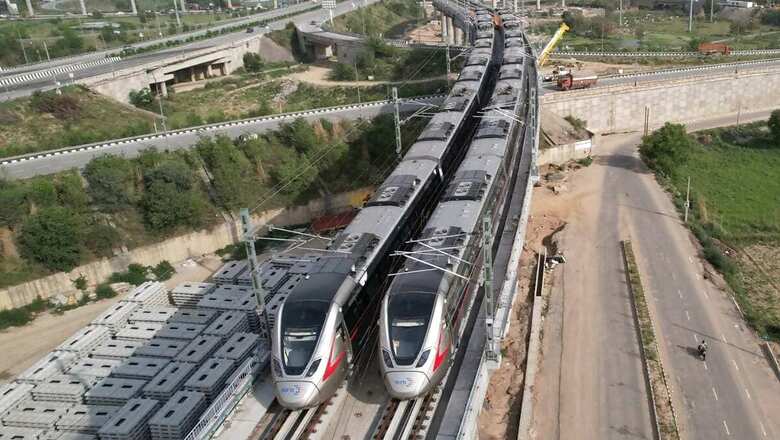
views
The Regional Rapid Transit System (RRTS) can operate at a maximum speed of 160 kmph on the priority corridor of the Delhi-Ghaziabad-Meerut stretch, a communication from the Railway Board, seen by News18, reads.
The letter, issued this week, mentioned that the train can operate “up to a maximum operational speed of 160 kmph in fully inflated mode and 140 kmph in deflated mode of secondary air spring” on the priority corridor of National Capital Region Transport Corporation Limited (NCRTC).
The 17-km priority section of Delhi-Ghaziabad-Meerut RRTS corridor has a total of five stations — Sahibabad, Ghaziabad, Guldhar, Duhai and Duhai Depot. This section is likely to be inaugurated this year. The RRTS trains were designed for 180 kmph speed and have been tested for an operating speed of 160 kmph. However, its average speed is going to be 100 kmph. The entire Delhi-Meerut section of 82 kilometres is likely to be completed around 2025.
Team #NCRTC building future-ready mobility infrastructure for an aspirational #NewIndia and geared up to serve the people of NCR. #RAPIDX #transformingIndia #MakeInIndia #atmanirbharbharat @ADB_HQ @NDB_int @AIIB_Official @WorldBank @ut_MoHUA @CMOfficeUP @PMOIndia pic.twitter.com/blhrrilR1P— Vinay Kumar Singh (@VKS_irse) April 27, 2023
RRTS is a new, dedicated, high-speed, high-capacity, comfortable commuter service. It is different from conventional railways as it will provide reliable, high-frequency, point-to-point regional travel. RRTS is also different from Metro as it caters to passengers looking to travel a relatively long distance with fewer stops and at a higher speed.
The letter also added that the ‘provisional sanction’ is subject to various stipulations from the Commissioner for Metro Rail Safety (CMRS) and Chief Commissioner of Railway Safety (CCRS).
In its stipulations, the CMRS mentioned that before initiating train operations, the NCRTC must certify track fitness and fitness of the rolling stocks depending upon the actual condition of the bogie suspension system, brake system, wheel, axle and other safety related components.
It also said the Railway Board-approved signalling system should be provided and integrated testing of the signalling system with rolling stock should be carried out before its commercial run.
“Brakes of the rolling stock shall be in good working order during the commercial operations and during other self-powered movements anywhere. All train operators and station/section controllers shall be given required training and shall be in possession of valid competency certificates issued by designated officers.”
The CCRS gave a number of stipulations as well but also listed suggestions for improvement in the trains. It said that the NCRTC should undertake a study to find out the effect of centrifugal forces and inertial forces on the human body while travelling in a standing position at a high speed of 160 kmph for one hour duration over a prolonged period of time.
They also suggested that for effective security surveillance, which is an important item in rolling stock, video analytics should be built in CCTV surveillance systems to ensure efficient monitoring of the system.
It said during the door obstruction test, it was observed that after three attempts the door was stopped in the same position slightly more than the width of the obstacle, suggesting that NCRTC should ensure that traction is disabled in such a scenario.
“The NCRTC shall ensure proper maintenance of rolling stock, propulsion equipment, signalling and interlocking, track, traction system and civil structures to ensure safe train working at 160 kmph,” they said.
The CCRS said the camera fitted outside the coach could not capture the picture of the platform with proper resolution during night. NCRTC should ensure the quality of the picture during night.
“Anti-finger capping brushes seen in ruptured condition in the doors need to be rectified. NCRTC may examine the possibility of providing optical fiber based Linear Heat Detection (LHD) for detection of heating zones especially in electrical panels in the coach area,” they added.




















Comments
0 comment